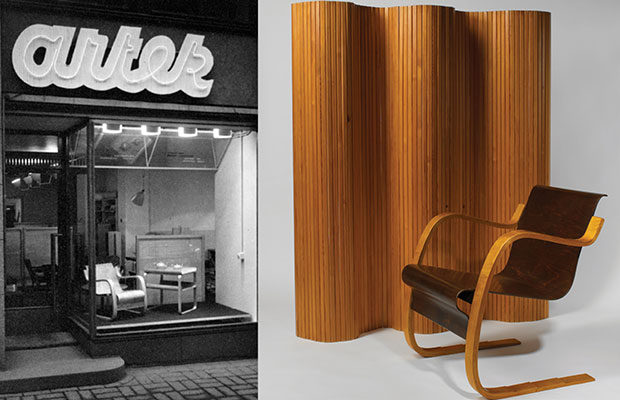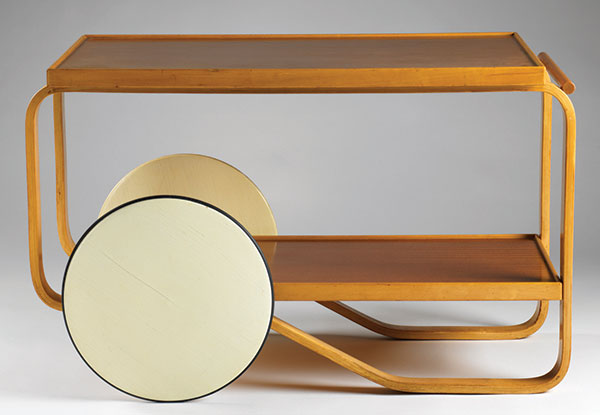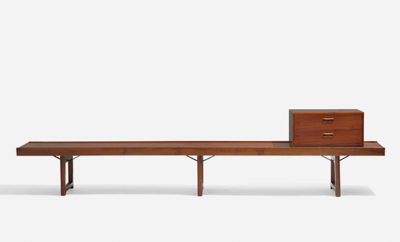 The Artek store in Helsinki, ALVAR AALTO MUSEUM, JYVÄSKYLÄ, FINLAND, ARTEK COLLECTION | Alvar’s birch screen and stepped-leg armchair. SCREEN: PRIVATE COLLECTION/ARMCHAIR: AALTO DESIGN-COLLECTION, PERTTI MÄNNISTÖ/ WHITE PHOTO
The Artek store in Helsinki, ALVAR AALTO MUSEUM, JYVÄSKYLÄ, FINLAND, ARTEK COLLECTION | Alvar’s birch screen and stepped-leg armchair. SCREEN: PRIVATE COLLECTION/ARMCHAIR: AALTO DESIGN-COLLECTION, PERTTI MÄNNISTÖ/ WHITE PHOTO
Feature
Artek, the Aaltos, and the Advocacy of Modernism
IMAGINE HOW IT MUST HAVE STRUCK HELSINKI’S RESIDENTS in the late 1930s when they had their first sight of the shop called Artek in the center of town. They would have seen cantilevered blond wood chairs with seats and backs that were a continuous flowing scroll. There would have been a teacart, maybe, with playful oversized wheels, and stacks of stools whose rounded L-shape legs rotated in a spiral. On the checkerboard tiled floor would be thick, abstractly patterned carpets. Against the walls, shelves of ribbed glasses and rippling freeform vases. Venturing into the space, they might have met, face to face, for the first time, artwork by Léger, Picasso, Gauguin, Toulouse-Lautrec, and Calder.
Founded in 1935 to market Aalto products, Artek survived the volcanic disruptions of twentieth-century geopolitics and endures to this day.
Artek was a business, brand, and emissary of the modern design philosophy practiced by the Finnish architect and designer Alvar Aalto and his first wife and creative partner, Aino Marsio-Aalto. Founded in 1935 to market Aalto products, the company survived the volcanic disruptions of twentieth-century geopolitics and endures to this day. Its history and contributions to interior design are the subject of Artek and the Aaltos: Creating a Modern World, a lovingly detailed exhibition on view through September 25 at the Bard Graduate Center Gallery in New York.
Organized primarily by Nina Stritzler-Levine, the gallery’s director, and Juhani Uolevi Pallasmaa, a Finnish architect and writer, Artek and the Aaltos makes the point that selling Aalto furniture internationally was only the most pragmatic of the company’s missions. The exhibition, which is supported by Artek, also raises Marsio-Aalto’s status from enlightened professional spouse to formidable colleague by highlighting her creative and management roles at the company, including leadership of its interior design division, called the “drawing office.”
from the 1920s, when the Aaltos attended the same architecture school in Helsinki and later married, to 1949, when Aino died of breast cancer at the age of fifty-four. Though we see later Artek products and projects, a couple of which were undertaken with Aalto’s second wife, Elissa, Marsio-Aalto is clearly the star of the show. This is apparent from the first display—digitized pages from her travel diary, in which she sketched inspirations from her European sojourns and noted the settings where Aalto furniture had migrated—to the drawings her husband made of her on her deathbed. In between, her design sensibility is showcased in colorful, straight-lined children’s furniture; a circa 1935 homey birch dressing table; the 1932 pressed glassware collection for Iittala called Bölgeblick; and the flamboyant zebra-striped upholstery for Aalto’s cantilevered 1936 Tank chair. (Visitors will find a physical example of the chair next to its photographic twin in a wall mural of the original Artek store interior.)
Among the show’s eye openers are examples of the Nordic classicism Aalto practiced in his youth, including an iron table leg he drew in 1924 with carved ruffles like the paper frills on a crown roast. Much later, his idea of a fancy appendage would be the 1954 X- (or fan-) leg that evolved from his bentwood technology in an organic blossoming of form.
Artek was started by a gang of four. Along with the Aaltos, there were Maire Gullichsen, a patron of the couple who was connected by birth and marriage to the Finnish corporation A. Ahlström, and Nils-Gustav Hahl, an art historian and critic. The company name is a portmanteau word combining “art” and “technology” and is believed to have been inspired by a lecture given by Walter Gropius at the opening of the 1923 Bauhaus exhibition in Weimar, Germany, titled “Art and Technology: A New Unity.” (The Aaltos, who traveled frequently in Europe, visited the Bauhaus in Dessau in 1930, five years before Artek was launched, and were close friends of László Moholy-Nagy, the Hungarian-born designer and artist who taught at the school from 1923 to 1928.)
A manifesto written at the time of the founding outlined Artek’s chief purposes: to organize modern art shows in a variety of mediums, to bring modernism into interior design, and to create publications—no, that word was too weak and was crossed out—propaganda for a modernist agenda. (The curators rendered the word as “advocacy” in an English translation displayed at the show, which doesn’t go quite as far in suggesting revolutionary zeal.) Hahl assumed the role of managing director, Marsio-Aalto became creative director, and Gullichsen organized the modern art gallery that was installed in the Artek store in Helsinki a year after it opened in 1936. A section of the Bard show hints at the experience with a handful of the late nineteenth- and early twentieth-century paintings, prints, and sculptures customers would have seen, along with glass vases by Gunnel Nyman and a textile by Dora Jung.
Hahl was killed in 1941, volunteering in the Continuation War between Finland and the Soviet Union, and Marsio-Aalto added his management job to her creative duties. But though the curators allude to the difficulty of running a European business on the brink of World War II, with Finland in constant battle with the Soviets and making an alliance with Germany, politics (and business ethics) are left in the background. Wall texts make only brief mentions of wartime dangers and privations. Nor do they refer to Aalto’s reluctant trip to Berlin in 1943 at the invitation of the Germans to meet Albert Speer and learn more about industrial standardization, a method dear to his heart. These subjects will be addressed in the exhibition catalogue due out in July from Yale University Press.
A manifesto written at the time of the founding outlined Artek’s chief purposes: to organize modern art shows in a variety of mediums, to bring modernism into interior design, and to create publications—propaganda—for a modernist agenda.
Instead, the show concentrates in an absorbing way on how Artek cultivated international product licensees and distributors, building strong markets, especially in the United States. (Sales figures suggest that the company was a leader in “progressive” furniture in America from 1947 to 1949.) The show also emphasizes the Artek drawing office’s collaboration on buildings designed both by Aalto (such as the 1946 Baker House dormitory at Massachusetts Institute of Technology, where much of the original furniture is said to still be in use) and by others (including work in 1947 for the Helsinki-Malmi Airport and the 1948 staff housing for the U.S. Embassy in Helsinki). Documents found in Artek’s archives, as well as those supplied by Aalto’s descendants, include logo treatments, purchase orders, and photographs of Artek pieces arrayed in homes and offices throughout the world.
Then there’s the actual furniture—both familiar and rarely exhibited specimens and sometimes a combination of both; for instance, the Paimio armchair originally designed in 1931–1932 for tubercular patients, is displayed next to a mold for contorting its looped bentwood frame. We learn that, despite Aalto’s innovations, it was still a hell of a process to shape the wood. The mold bears the scars of repeated efforts.
The Paimio chair was one of the works that gave rise to Artek. The three-legged stool no. 60 that Aalto designed a year later for his Municipal Library building in Viipuri, Finland, was another. “It’s amazing what he did in that short period of time—all that experimentation that served him for decades,” notes Cara McCarty, the curatorial director of the Cooper Hewitt, Smithsonian Design Museum. She was referring to the Aaltos’ deliberately simple kit of forms and materials, which was the foundation of their product vocabulary, a language that found variety not in the number of components but in the way they were sized, colored, and arranged. Artek and the Aaltos is a proof-in-the-pudding demonstration of how right that thinking was. Eighty years later, the company (which is now owned by Vitra) is still around and the design looks relevant. If those achievements aren’t worthy of advocacy, I don’t know what is.

Oversized wheels on Aino’s tea trolley (model 98) show her spirited design sense. | PRIVATE COLLECTION/ BRUCE WHITE PHOTO










